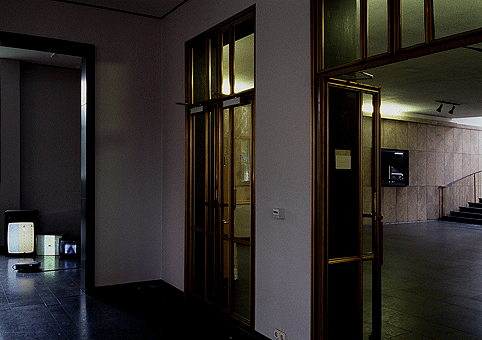"Am I really here or is this only art?"
(Laurie Anderson)The foyer and stairwell of Lower Saxony's Ministry of Art and Science are connected by a row of glass doors allowing visitors a view from the front entrance hall to the stairs behind. Alexander Steig creates a further visual connection by means of live video transmission. The installation LIFT is in effect an advance display of the ministry's existing visual conditions, as visitors to the building are able to view what awaits them in the stairwell via a group of monitors in the foyer. In previous works Steig has already utilised observation scenarios without emphasising their actual disciplinary function. His intention has always been to use video observation as a yet uncodified media option in contexts for which it was not originally intended. In LIFT the presentational form of the images transmitted into the foyer also contradicts that of conventional observation systems in public buildings. The arrangement here is as follows:
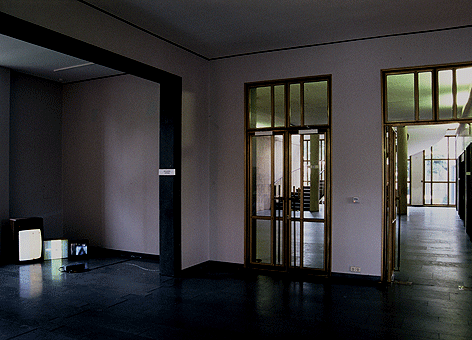
LIFT, Ministry of Science and Culture, Hannover, Lower-Saxonya view of the two lifts in the stairwell is projected via video projector onto a cardboard box, which is flanked left and right by two monitors. One of these, tipped onto its side in vertical format, shows the old-fashioned illuminated floor number display located above the lift doors. A smaller monitor shows an unfocussed close-up of the call-button. The three-part image of a lift, presented in different formats, together with the use of a cardboard box as a projection screen, stresses the model character of the arrangement - a media model representing three different functional components of a lift corresponding to three different aspects of an event. Translated into moving images, the successive numerical blinking of the illuminated display indicates a temporal process, the call-button signifies the initiation of activity - and its operation has an immediate visual effect on the two neighbouring images - and the doors provide the context within which every lift user, through his or her screen presence, becomes the protagonist of a scene.
Steig thus isolates three principle constituents of a performance, a live performance presented as a visual model: duration, action, protagonist/body. Two additional aspects should also be mentioned: the particular type of media presence and the site-specific nature of the work, incorporating both the host space and its users. Real-time images and live transmission versus everyday activity, routine, daily repetition.
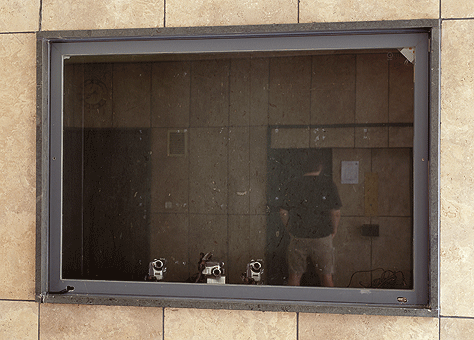
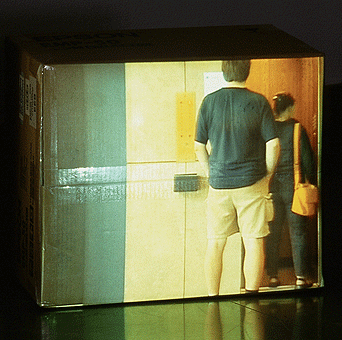
LIFT, Ministry of Science and Culture, Hannover, Lower-Saxony"Liveness", performance and a monitor image suggesting real-time recording - such a constellation was also central to one of Steig's earlier works, which like LIFT at first implied an observation situation. In ARBEITSRAUM (SLEEPING/WORKING) 2000 the sleeping artist was videoed continuously for a whole night, and the tape was later played on a monitor in the same studio/bedroom situation in which the sleep performance took place. In this piece the gap between recording and performance was temporal, whereas in LIFT only the glass doors and a distance of a few metres separate performance and reception. The parallel to Andy Warhol's six hour-long film SLEEP, of 1963, is an interesting aspect of ARBEITSRAUM (SLEEPING/WORKING), as the reference reignites the film/real-time debate of the 1960s and 70s sparked off by Warhol's films SLEEP and EMPIRE. Because of their one-to-one equivalence between film time and recording time, the long, unedited shots represented a stylistic device within a formal filmic realism starkly opposed to the "illusory" montage technique of commercial cinema. By providing the audience with a space for active reflection, the films' long shots and static camera promised a continual renegotiation of the viewer's role in perceptive production. In other words, the particular theatricality of these films emerges exactly within the confrontation of the viewer's perceptive habits by the material presence of the filmic images. The long shots make watching the films into a performative act characterised by the friction between image, meaning and perception, with the viewer as an active participant whose (re)actions essentially (co-)determine the performance.
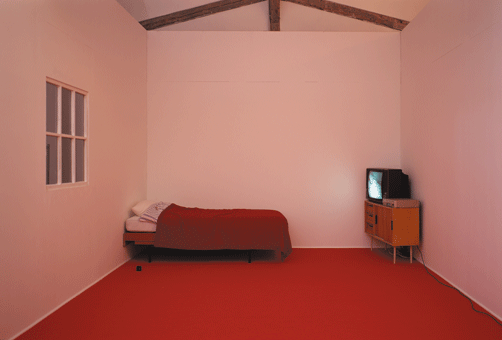
ARBEITSRAUM (sleeping/working), 2000, Art IG, HannoverIt is exactly these connections between performance, media presence and perception that are examined in Steig's installations LIFT and ARBEITSRAUM (SLEEPING/WORKING), although the experimental approach differs in each piece. In both works the body of the performer - its physical presence in the world - is confronted in a commonplace situation by the possibilities inherent in moving image media. The everyday can thus take on quite different forms. The lift doors of a cultural ministry are as ordinary to a civil servant as a bed in a bedroom will be familiar to every exhibition visitor. Spaces are chosen which scarcely command their users' attention, which are as much a part of the daily routine as the activity conducted within them. There is a decisive parallel here to Warhol's motivic choices. Because of its relative perceptual meaninglessness, it is precisely the most commonplace that is best suited for re-evaluation. Steig is concerned here with the principle of performativity, which has less to do with meaning in itself than with the possibility of continual reinterpretation, rethinking and reassessment.
Steig's approach puts at our disposal the process of everyday performance, by which he emphasises the necessity of continual self-invention in relation to others - or also as a basic self-reflexive category of human existence - as one of the essential conditions for subjectivity. With the structural rigorousness of an early Warhol film, Steig offers the viewer the possibility of standing aside from oneself to reflect upon the process of self-perception. But his installation is situated entirely within the hypothetical. The commonly applied strategy of using media effects to overwhelm the viewer is here substituted by a reflective system that places the same effects of performance, media presence and perception in relation to one another in a model-like arrangement. The questions raised by this experiment deal with the possibilities of individual self-invention, but the creative potential of such strategies may also be examined as a general culturally determined principle. The renegotiation of actions and their meanings has after all always been the prerogative of art, and Steig's installations place such a potential on the agenda. And doing so in a place where cultural questions are the subject of daily administration can only be understood as a challenge.
Ariane Beyn, Berlin 2002
Translated by Michael Turnbull, Berlin
(Catalogue "LIFT", Ministry of Science and Culture, Hannover, Lower-Saxony, 2002)
